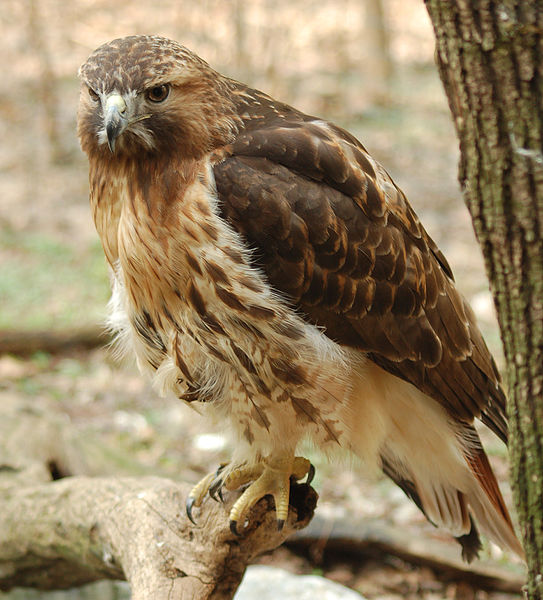
Once thought to be meadow, wood and stream dwellers, several species of hawk have become yuppies, moving into suburban areas, seemingly without fear.
Weeding a flower bed during one of the few balmy days of early April we hear the asthmatic squeal of a red-tailed hawk. The closeness of the "keer-r-r, keer-r-r" startles us. Looking up, there sat two red-tailed hawks in a large sweet gum tree in a neighbor's yard, the branches where the hawks are perched hanging over our heads.
Were the hawks there when we came out into the yard? We don't know. But now a big black crow is harassing them. The two leave the tree together and begin ascending the warm thermals. They are oblivious to the crow chasing them, the black tormentor using all the expletives in crow language as he follows them skyward.
The two hawks rise slowly in spirals and circles, with the crow screaming and mounting with them. The crow shoots from one bird to the other, squawking and seemingly slapping their backs. In ascending spirals, the hawks soon appear no larger in size than a robin. At last the antagonizer, so high in the sky he appears the size of a chickadee, gives up and descends earthward disappearing over the hill.
It is only minutes before the soaring hawks are back over our yard, still flying not far above the treetops with outstretched wings and tail.
On a balmy day a few days before, we watched the nuptial flight of two hawks. Hearing a blue jay's call, we think, the call being similar to a red-shouldered hawk's cry, we look toward the wooded lot from where the call had come.
Gazing skyward we are surprised to see two red-shouldered hawks flying in circles and touching wings, or so it seems. Such beautiful and majestic movements as they play around in the warm thermals.
Sailing in wide spirals, balancing on wide, outstretched wings, tails wide open like a fan, floating serenely with no apparent effort, they seem to be enjoying their honeymoon flight.
Most hawks mate for life, though they go through nuptial festivities each spring. We haven't located a nest yet, but last summer red-shouldered hawks hung out in the wooded lot and the wooded buffer zones between neighbor's houses.
These two big buteos have been accused of taking chickens but research has shown they seldom take poultry. Their main diet is mice, moles, squirrels, rabbits, grasshoppers and other large insects. The morning we observed the red-tails we found a squirrel's tail in a flower bed, perhaps a victim of the hawks.
The rufous red tail is one of the best identifying marks of the brown-backed red-tailed hawk. Heavy dark bands across both sides of the tail are a good field mark of the red-shouldered hawk. The red shoulders can't always be seen from below.
Although the sexes of both species are similar, females are usually larger. Both hawks are residents of the Central Savannah River Area. Each species increases in number in winter when the more northern nesting hawks come south for some rest and relaxation.
